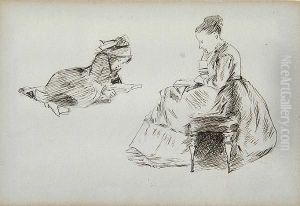Henry Eddowes Keene Paintings
Henry Eddowes Keene, a notable figure in British colonial art, was born in 1826 and passed away in 1885. His life and work are often associated with the British Raj in India, where he spent a significant portion of his career. Keene was not only an artist but also an engineer, which influenced his artistic perspectives and the subjects of his works. His contributions to art are particularly remembered for their detailed portrayal of Indian landscapes, architecture, and life during the 19th century, offering a unique blend of technical precision and artistic sensibility.
After completing his education in England, Keene embarked on a journey to India, drawn by the promise of employment in the burgeoning colonial administration and the allure of the subcontinent's exotic landscapes. His dual talents in engineering and art made him an invaluable asset to the British colonial efforts, as he was often tasked with documenting the newly encountered landscapes, architectural wonders, and scenes of daily life in India. Keene's works serve as historical documents, providing insight into the cultural and physical landscape of 19th-century India under British rule.
Throughout his career, Keene contributed to various publications and undertook numerous projects that required a keen eye for detail and a deep understanding of the environment he was capturing on canvas. His art, characterized by its realism and attention to detail, was highly regarded by his contemporaries. However, it is his ability to convey the beauty and complexity of Indian life that has ensured his lasting legacy in the art world. Keene's works are now considered valuable for their historical and aesthetic qualities, offering a window into the past for both art historians and general audiences alike.
Despite his significant contributions to the field of art, Henry Eddowes Keene remains a somewhat obscure figure, overshadowed by the more famous names of his time. Nevertheless, his art continues to be studied and appreciated by those interested in the British Raj, colonial art, and the intricate relationship between the colonizer and the colonized as depicted through the lens of an artist-engineer. Keene's death in 1885 marked the end of a career that had spanned several decades, leaving behind a body of work that continues to be admired for its historical value and artistic merit.

